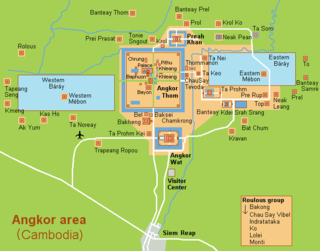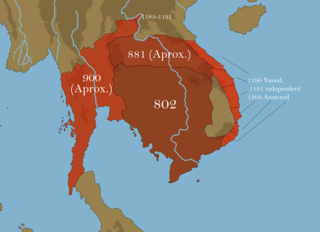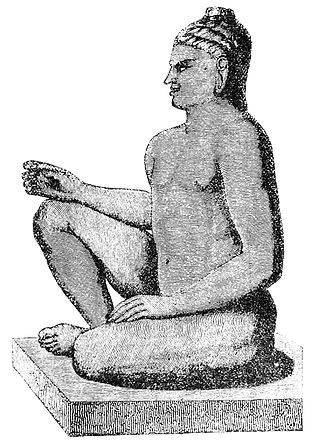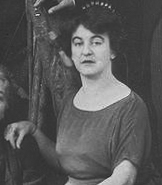
Khmer architecture, also known as Angkorian architecture, is the architecture produced by the Khmers during the Angkor period of the Khmer Empire from approximately the later half of the 8th century CE to the first half of the 15th century CE.

Angkor, also known as Yasodharapura, was the capital city of the Khmer Empire. The city and empire flourished from approximately the 9th to the 15th centuries. The city houses the Angkor Wat, one of Cambodia's most popular tourist attractions.

The Khmer Empire, or the Angkorian Empire, is a term used by historians to refer to Cambodia from the 9th to the 15th centuries, when the nation was a Hindu-Buddhist empire in Southeast Asia. The empire grew out of the former civilizations of Funan and Chenla, which at times ruled over and/or vassalised most of mainland Southeast Asia and parts of Southern China, stretching from the tip of the Indochinese Peninsula northward to the modern Yunnan province of China, and from Vietnam westward to Myanmar. At its peak, the Khmer Empire was larger than the Byzantine Empire, which existed around the same time.

Jayavarman VII, posthumous name of Mahaparamasaugata, was king of the Khmer Empire. He was the son of King Dharanindravarman II and Queen Sri Jayarajacudamani. He was the first king devoted to Buddhism, as only one prior Khmer king was a Buddhist. He then built the Bayon as a monument to Buddhism. Jayavarman VII is generally considered the most powerful of the Khmer monarchs by historians. His government built many projects including hospitals, highways, rest houses and temples. With Buddhism as his motivation, King Jayavarman VII is credited with introducing a welfare state that served the physical and spiritual needs of the Khmer people.

Phnom Bakheng is a Hindu and Buddhist temple in the form of a temple mountain in Siem Reap Province, Cambodia. Dedicated to Shiva, it was built at the end of the 9th century, during the reign of King Yasovarman (889–910). Located atop a hill, it is nowadays a popular tourist spot for sunset views of the much bigger temple Angkor Wat, which lies amid the jungle about 1.5 km to the southeast. The large number of visitors makes Phnom Bakheng one of the most threatened monuments of Angkor. Since 2004, World Monuments Fund has been working to conserve the temple in partnership with APSARA.

Banteay Srei or Banteay Srey is a 10th-century Cambodian temple dedicated to the Hindu god Shiva. Located in the area of Angkor, it lies near the hill of Phnom Dei, 25 km (16 mi) north-east of the main group of temples that once belonged to the medieval capitals of Yasodharapura and Angkor Thom. Banteay Srei is built largely of red sandstone, a medium that lends itself to the elaborate decorative wall carvings which are still observable today. The buildings themselves are miniature in scale, unusually so when measured by the standards of Angkorian construction. These factors have made the temple extremely popular with tourists, and have led to its being widely praised as a "precious gem", or the "jewel of Khmer art."

Yasovarman I was an Angkorian king who reigned in 889–910 CE. He was called "Leper King".

Maurice Glaize was a French architect and archeologist, Conservator of Angkor from 1937 to 1945.

Siem Reap is the second-largest city of Cambodia, as well as the capital and largest city of Siem Reap Province in northwestern Cambodia.
Madeleine Giteau was a French historian and member of the Ecole française d'Extrême-Orient, who devoted a great part of her life to research involving Laotian and Cambodian art, especially Khmer sculpture and iconography.

Henri Marchal was a French architect and civil servant. He devoted a great part of his life to research on the art and archeology of Cambodia and the conservation and restoration of Khmer monuments at the archeological site of Angkor, in Cambodia.

Louis Finot was a French archeologist and researcher, specialising in the cultures of Southeast Asia. A former director of the Ecole française d'Extrême-Orient, his contribution to the study of Khmer history, architecture and epigraphy is widely recognised.

The Phnom Kulen National Park is a national park in Cambodia, located in the Phnom Kulen mountain massif in Siem Reap Province. It was established in 1993 and covers 373.76 km2 (144.31 sq mi). Its official name is Jayavarman-Norodom Phnom Kulen National Park.
A Dharmasala or a house of fire, or house with fire, is the name given to a place where people, especially pilgrims, can rest on a journey. It is a type of building found in Angkorian complexes constructed during the reign of late 12th-century monarch Jayavarman VII and still found in Preah Khan, Ta Prohm and Banteay Chhmar.
Khin Sok was a Cambodian historian, linguist, literature and arts scholar. He acquired a doctorate of history in Paris, published scientific works, taught as a professor in the Royal University of Phnom Penh and was a member of the Royal Academy of Cambodia. His publications during the second half of the 20th century profoundly contributed to the scientific interpretation of historical sources, literature and the systemic development of the modern Khmer language. As a participant of the Khmerization movement he encouraged the promotion of a culturally independent Cambodia on the basis of enlightened and scholarly education in an international context.
George Groslier was a French polymath who – through his work as a painter, writer, historian, archaeologist, ethnologist, architect, photographer and curator – studied, described, popularized and worked to preserve the arts, culture and history of the Khmer Empire of Cambodia. Born in Phnom Penh to a French civil servant – he was the first French child ever born in Cambodia – Groslier was taken by his mother to France at the age of two and grew up in Marseille. Aspiring to become a painter, he tried but failed to win the prestigious Prix de Rome. Shortly afterwards, he returned to Cambodia, on a mission from the Ministry of Education. There he met and befriended a number of French scholars of traditional Cambodian culture. Under their influence, he wrote and published, in France in 1913, his initial book on this subject: Danseuses Cambodgiennes – Anciennes et Modernes. It was the very first scholarly work ever published in any language on Cambodian dance. He then returned to Cambodia, traveling the length and breadth of the country to examine its ancient monuments and architecture. From this experience came his book A l'ombre d 'Angkor; notes et impressions sur les temples inconnus de l'ancien Cambodge. In June 1914, Groslier enlisted in the French army and was employed as a balloonist in the early part of World War I. It was during this time that he met and married sportswoman Suzanne Cecile Poujade; they eventually had three children.

Jean Boisselier was a French archaeologist, ethnologist, and art historian. He was a specialist on Khmers and a researcher focused on Buddhist thought and iconography. As a member of the École française d'Extrême-Orient (EFEO), he was responsible for the restoration of Angkor.
Bruno Dagens is a French archaeologist, art historian, Sanskritist, and a specialist on Angkor Wat. He is currently a professor emeritus of the University of Sorbonne Nouvelle Paris 3.

Jeanne Leuba was a French journalist, writer and poet. Having spent many years in Indochina and Cambodia, she is considered one of the most impressive of the women colonial novelists.

A Ballista elephant also known as a Khmer ballista is a war elephant mounted with a simple or double-bowed ballista which was used by the Angkorian civilization. They are considered as the summit of sophistication of Khmer weaponry comparable to the carrobalista in the legion of Vegetius.


















